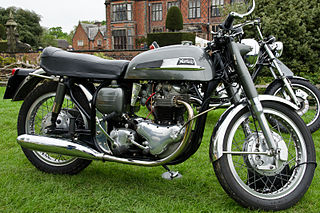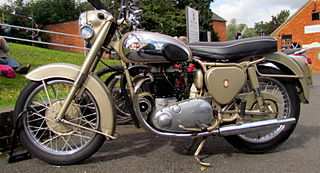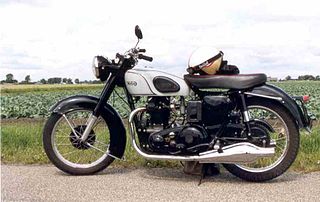Related Research Articles

The Norton Motorcycle Company is a brand of motorcycles headquartered in Solihull, West Midlands,, England. For some years around 1990, the rights to use the name on motorcycles was owned by North American financiers.

The Vulcan name has been used by Kawasaki for their custom or touring bike since 1984, model designation VN, using mostly V-twin engines ranging from 125 to 2,053 cc.

Associated Motor Cycles (AMC) was a British motorcycle manufacturer founded by the Collier brothers as a parent company for the Matchless and AJS motorcycle companies. It later absorbed Francis-Barnett, James, and Norton before incorporation into Norton-Villiers. Henry Herbert Collier founded Matchless as a cycle company in 1878. His sons Henry (Harry) and Charles (Charlie) joined him and the name was changed to H. Collier & Sons.

The Norton Commando is a British Norton-Villiers motorcycle with an OHV pre-unit parallel-twin engine, produced by the Norton Motorcycle company from 1967 until 1977. Initially having a nominal 750 cc displacement, actually 745 cc (45.5 cu in), in 1973 it became an 850 cc, actually 828 cc (50.5 cu in). It had a hemi-type head, similar to all OHV Norton engines since the early 1920s.

The Dominator is a twin cylinder motorcycle developed by Norton to compete against the Triumph Speed Twin. The original Dominator was designed in 1947 and 1948 by Bert Hopwood, who had been on the Speed Twin design team at Triumph. Available for sale from mid 1949, this design set the pattern for Norton twins for the next 30 years.

The Norton Atlas was a Norton motorcycle made between 1962 and 1968, until it was replaced by the Norton Commando.

The Norton International or Cammy Norton is a Norton Motors Ltd overhead cam (OHC) motorcycle built between 1931 and 1957.

The featherbed frame was a motorcycle frame invented by the McCandless brothers and offered to the British Norton motorcycle company to improve the performance of their racing motorcycles in 1950. It was considered revolutionary at the time, and the best handling frame that a racer could have. Later adopted for Norton production motorcycles, it was also widely used by builders of custom hybrids such as the Triton, becoming legendary and remaining influential to this day.

The Norton P11 is a 745 cc (45.5 cu in) air-cooled OHV parallel twin motorcycle that was made by Norton-Villiers from 1967 to 1969. Designed as an extremely light high power-to-weight ratio desert racer, P11 was revised in 1968 to the P11A and marketed as the Norton Ranger, a road legal version of the P11 with a more comfortable seat to make it suitable for normal road use. The Norton P11 gained a reputation as a 'desert racer' in the late 1960s but by 1969 lighter two stroke desert racers began to dominate the sport and the Norton had begun Commando production and it was selling well. Norton ended production of the P11 series to concentrate on the Commando, which used a number of ideas developed on the P11 series.

The BSA C15 was a 250 cc single-cylinder ohv motorcycle manufactured by the British company BSA from September 1958 until 1967, and was BSA's first four-stroke unit-construction bike. For most of that period, after the introduction of 'Learner Laws' in 1961, a 250 cc was the largest capacity solo machine that a learner could ride unaccompanied when displaying L-plates in the United Kingdom. A road-going Sports derivative was added in 1961, and off-road versions, for Trials and Scrambles, were also available in the range.

The BSA A10 series was a range of 646 cc (39.4 cu in) air-cooled parallel twin motorcycles designed by Bert Hopwood and produced by Birmingham Small Arms Company at Small Heath, Birmingham from 1950 to 1963. The series was succeeded by the A65 unit construction models.

The BSA B44 was a series of 441 cc (26.9 cu in) unit construction single-cylinder OHV four-stroke motorcycles made by the Birmingham Small Arms Company between 1966 and 1970. The machines were developed from the BSA World Championship Motocross machines, which were themselves based on the C15/B40.

Bridgestone motorcycles were a division of the Bridgestone Tire Co. of Kyōbashi, Tokyo, Japan that produced mopeds and motorcycles from 1952 to 1970. Initially producing power assisted bicycles, the division moved on to producing mopeds and then motorcycles. The motorcycles were technologically advanced and powered by two-stroke engines. The high technical specification resulted in the machines being more expensive compared to other manufacturers models. Production was stopped in 1970 to protect the supply of tyres to other manufacturers.

The Norton Commando Production Racer was a hand built production racer produced by Norton-Villiers from 1970 - 1972. It was based on the road-going Norton Commando, and although fitted with lights it was never intended as a road bike. The model was commonly known as the Yellow Peril.

The Norton Model 7 Dominator was a 500 cc vertical twin motorcycle manufactured by the Norton Motorcycle Company from 1949 to 1955. It was the first of Norton's Dominator range of motorcycles. The engine was designed by Bert Hopwood and was a departure from Norton's previous practice of producing single-cylinder machines. The Model 7 was used in Japan as a police motorcycle.
The Norton Model 77 Dominator was a 600 cc vertical twin motorcycle manufactured by the Norton Motorcycle Company from 1956 to 1958. It was based on the Model 7 that it superseded, and was primarily intended for sidecar use. Norton modified the featherbed frame of the 88 and 99 models in 1957 to be suitable for sidecar use making the Model 77 superfluous and the model was dropped in 1958.

The Norton Model 88 Dominator, also originally known as the Dominator De Luxe was a 500 cc vertical twin motorcycle manufactured by the British Norton Motorcycle Company from 1952 to 1966. It was the first of Norton's motorcycles to use the featherbed frame, which established Norton's reputation of producing fine handling machines. The 88 used the Bert Hopwood designed engine that was first fitted to the Model 7 and was initially for export only. It became available on the home market in 1953. Norton were a small manufacturer at the time and without the economies of scale the model was expensive compared to other manufacturer's equivalent machines. The 88 retailed for 20% more than the contemporary Triumph Speed Twin and was dearer than the 650 cc Triumph Thunderbird.

The Norton Model 99 Dominator was a 600 cc vertical twin motorcycle manufactured by the British Norton Motorcycle Company at their Bracebridge St, Birmingham factory from 1956 to 1962. The 99 was based on the 500 cc Model 88 Dominator with an enlarged engine. The model was superseded by the 650SS.
The Norton Manxman was a 650 cc vertical twin motorcycle manufactured by the British Norton Motorcycle Company at their Bracebridge St, Birmingham factory for export. The engine was an enlargement of the 600 cc engine used in the Model 99 Dominator. The Manxman was first shown at the November 1960 Earls Court Motorcycle Show and listed by the American importer, Berliner, in their catalogue from 1961 to October 1962 Berliner had asked for the model to be named Manxman although the twin had never been raced at the Isle of Man.

The Norton 650 Dominator was a 650 cc vertical twin motorcycle manufactured by the British Norton Motorcycle Company from 1962 to 1967. Initially production was at Norton's Bracebridge St, Birmingham factory, but following the factory's closure in 1963, production was transferred to parent company AMC's works in Plumstead, London. Initially produced in single and twin carburettor versions, the single carb version was soon discontinued. The twin carb version, the 650SS, was described as the 'Best of the Dominators'.
References
- 1 2 3 4 "c.1958 Norton 750cc Nomad Frame no. MB73922 Engine no. N15CS117680". Bonhams. Retrieved 16 June 2021.
- 1 2 3 4 "1958 600cc Norton Nomad". National Motorcycle Museum . Archived from the original on 21 January 2015. Retrieved 16 June 2021.
- ↑ Morin, Paul (2013). "THE ATLAS HYBRIDS - AJS and Matchless Archives" . Retrieved 16 June 2021– via yumpu.com.
- ↑ "Top 5 Bike-uriosities - Week of January 16 2017". RideApart.com. Retrieved 16 June 2021.
- ↑ "The South of England Classic Motorcycle Show" (PDF). www.elkpromotions.co.uk. Retrieved 16 June 2021.